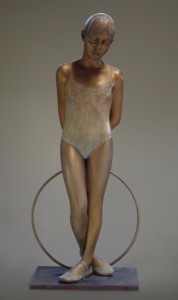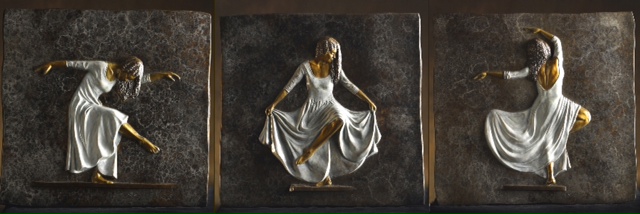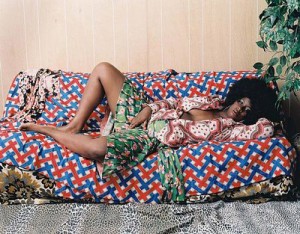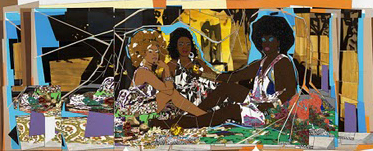Last summer I was dangling my feet over a pool in Big Sky, Montana, watching my granddaughter Averyl dive for goggles, when I overheard a conversation about art and sculpture. Behind me on a deck chaise, a gentleman with a bushy moustache handed me his catalog; artist Rodd Ambroson entered my art sphere.
Ambroson, who maintains a studio in Joseph, Oregon is a former medical illustrator turned guitar playing-sculptor. His keen observations developed as a medical school T/A led to textbook illustration and finally to fine art. Like philosopher Hegel, he feels the historical spirit of art and like academic Kant, he believes in those who are privileged to understand beauty.
Post Modernism (the ‘ism’ that maybe we have just left-???) didn’t embrace pretty. But beauty and portraiture continue to fascinate; like the gopher in Caddy Shack, it just keeps popping up. Modern Realism surfaced in the early nineteenth century as Romanticism. Man’s individuality, the Self, as a physical celebration coming out of Enlightenment thinking, appeared in music (Chopin), in poetry (Wordsworth), in fiction (Shelley) and on canvas (Caspar David Friedrich).
A few months ago Paul Emsley’s portrait of the Duchess of Cambridge was unveiled at London’s National Portrait Gallery, causing a big fuss. Naysayers said Kate appeared old and looked like a shampoo advertisement. The rendering was not avant-garde for twenty-first century Conceptual audiences who like found objects thrown about gallery floors for discussion.
No, Emsley didn’t chop and rearrange body parts like Francis Bacon, or lay on the paint like Lucian Freud–not that there’s anything wrong with that either. And the work probably won’t puzzle generations as to what was being communicated as in Van Eyck’s Arnolfini Marriage, the one where the woman looks pregnant, shoes litter the foreground and the proud artist appears as a snoop in his concave mirror behind. Vive La Difference!
Rodd Ambroson is a contemporary Renaissance artist who enters his studio early in the morning and begins playing guitar as a meditation warm-up. His folk music inspired by living in Wallowa County, Oregon, appears on a CD, Songs from the End of the Road. Working in clay, he models the female who will eventually be cast in bronze. This Ambroson folk song about women nicely binds the two genres he loves:
Hymn to Her
I came to you, a rolling river
Water bound to roam
You placed a stone
Changed my direction
Made me feel I belong.[Chorus]
How can I say I love you
And not mean it like a prayer
I came to you, winding water
So grateful you were there(Rodd Ambroson, 2004)
Once Ambroson feels a figure is finished, the clay body gets sent off to be cast into bronze. Over the phone, Ambroson laughed that the first time he saw the foundry cut his figure apart he was a bit unnerved. Lost-wax, the ancient method of bronze casting, has been updated by first coating the clay body parts with liquid silicone and eventually using a silica cement shell for the vessel in which molten bronze is poured.

Channels resembling drinking straws (gates and sprues) are meticulously made as they have been for centuries, to allow the molten bronze to flow into interstices of the piece. Ambroson sculpts women in the nude or wearing diaphanous shifts so bone structure and muscle can be admired. Often these ladies are holding a prop, a watering can or a basket.
Ambroson enjoys sculpting hair which he says becomes a unique element in itself. Just as when composing music, he looks for line quality and rhythms. An excerpt from Ambroson’s catalog Sculpting Beauty from the Heart:
My figures are intelligent and genuine in their expressions. They are more than just portraits of any individual. They represent universal human ideals and emotions. I’ve always been introspective and my fingers are, as well. I like people to look at a piece and fall into that state of mind: “Joy,” “Serenity,” “Contemplation,” etc.
Although much of his work stands about three feet high, he has executed a life size commission, The Lady in the Hat, for the Port of Kennewick, Washington. Another commission for the Port is in progress and involves two Native American figures, harvesting Tule, a reed used by aboriginals for making baskets and canoes.

Bronze is a very cold material. A good sculptor must push through the metal and breathe warmth into the figure as does Ambroson. This can be tricky when rendering the figure in bas-relief. Ambroson’s Three Graces begins as 3-D women with flowing skirts, but become trapped as they dance on a 2-D bronze plane similar to stretched canvas used for a painting. Bas-relief combines illusions found on a flat surface with dimensions found in sculpture, all conveying being alive. The renowned nineteen century American sculptor Augustus Saint Gaudens sold many bas-reliefs. (www.roddambroson.com)
This past New Year’s, I flew to New York City to meet up with my online PhD group. After reading my Ashcan School paper at Baruch College, I took the subway to Gotham’s understated treasure house. The Brooklyn Museum not only has great nineteenth century American Art and Classical Greek statuary but has become a center for Feminist art with Judy Chicago’s The Dinner Party.
The City was damp and drab until I walked into Mickalene Thomas’ solo exhibition, Origin of the Universe, and was blown away by loud primaries and varied shapes embedded with rhinestones. Life size tableaux of conventional living areas made from plaids and stripes were happily tessellated to form large 3-D compositions. The viewer forgets feelings associated with the ordinary and focuses on the design quality of these large units. I love connections:
Thomas resides on Carlton Avenue having completed her undergraduate studies at Pratt Institute. My mother grew up on Carlton Avenue, also studying at Pratt. Thomas earned an MFA from Yale where our paths might have crossed had I not found myself painting at the University of Chicago.
Thomas is an African American artist who like author Franz Fanon is not “mired by the determinations of the past.” All good art begins with Form which provides the impetus for the viewer to keep looking. Thomas can draw the figure well too. There is Content in her art or the reason the onlooker keeps going back, buying the exhibition catalog and Googling favorite imagery afterwards.
Thomas’ African American women radiate confidence as they burst from the picture plane, well dressed, while wallowing in purposely uncoordinated prints and stripes. Her work is reminiscent of sculptor Nick Cave’s headless bodies. Cave rummages thrift shops stuffing and sewing fabric that the fashion world wouldn’t dream of juxtaposing. It has been suggested Thomas’s use of XL rhinestones in place of jewelry or makeup reference 60’s Pop Art.
A Thomas quote from the exhibition catalog:
“Perhaps, I think it’s too easy for one to associate my work to bling! My Paintings are much more complex and complicated.”
Yes, they are more complicated and she isn’t commercial. Her paintings don’t allude to the post-war advertising world of selling Cokes or Brillo pads. The props in her works are supporting cast members to the figures, they don’t dominate compositions. Thomas is empowering all women much the same way men have historically been promoted.
Yet the fabrics are recycled from thrift shops where the poor are often forced to shop, posing more complexity of thought. Some of her pieces are painted collages devoid of the body and suggest David Hockney’s patterning. He often reassembles forms so the resulting picture feels as though it is moving through space with new content.

Like artist Cindy Sherman, Thomas often positions herself in her narratives that allegorically recycle and update masterpieces. In a C-print entitled, Afro Goddess with Hands Between Legs, 2006, Thomas lies on a red/ blue lattice patterned sofa dressed in a blouse and skirt, all of contrasting prints. On her head is an oversized afro. Thomas is satirizing Titian’s Venus of Urbino, 1538. Although both images are charged with sexuality, Thomas doesn’t portray herself as the kept woman and is free to walk away after the shutter clicks.
Thomas’ satire of Manet’s Le déjeuner sur l’herbe, 1863, removes the two frock-coated males and their nude companion replacing the triangular-threesome with Le déjeuner sur l’herbe: Les Trois Femmes Noires, 2010, or three black women. Manet’s grass and trees have been replaced with a Thomas collage of greenish prints in the foreground and bits of plywood paneling in the background, the kind found in post-war rec rooms. Whoever Thomas’ women are, the three take up equal space on the picture plane without the need for men.

In Landscape with Woman Washing Her Feet, 2008, Thomas plays upon Poussin’s Landscape with a Woman Washing her Feet, 1650, removing figures as well as the buildings and trees. She replaces Poussin’s representative narrative with total abstraction leaving the viewer to search for humanity.
In Thomas’ faux Poussin, her sky is blue; her trees are green and her black pond becomes the foreground focus, albeit non-representational. The viewer may find a Thomas work more of a riddle than an allegory. (The Origin of the Universe by Mickalene Thomas, available on Amazon, and Thomas images on Google Search)
Rodd Ambroson and Mickalene Thomas portray women in different ways on opposite sides of the country. Both show women as independent beings while pushing and pulling beneath surfaces of their chosen media to proclaim inner strengths and to express beauty.




